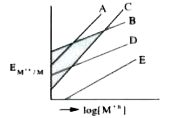Nernst equation gives the variation of potential of an electrode based on activity of ions temperature and pressure. The equation is
E=E∘−2.303RTnFlogQ(or)E=E∘−0.0591nlogQ
E∘= Standard potential and 'Q' is the reaction quotient.
Which cell has least potential ? Solution in Telugu
ZN/Zn+21M/Cu+21M/Cu
Zn/Zn+20.1M//Cu+20.1M/Cu
Zn/Zn+20.1M/Cu+21M/Cu
Zn/Zn+21M/Cu+20.1M/Cu
The correct Answer is:D
Ecell=E0cell+0.0591nlog[Cu+2][Zn+2]
[Cu+2]↑⏐⏐Ecell↑⏐⏐
[Cu+2]⏐⏐↓Ecell⏐⏐↓
 E = E^(0) + (0.0591)/(n) log) Metallurgy , Refer Ellingham Diagram
Metallurgy , Refer Ellingham Diagram
According to this graph lower line metal reduce upper line metal
Topper's Solved these Questions
- ELECTROCHEMISTRY BOOK - AAKASH SERIESCHAPTER - ELECTROCHEMISTRY EXERCISE - PRACTICE SHEET -5 (LINKED COMPREHENSION TYPE QUESTIONS (PASSAGE-II))
3 Videos
- ELECTROCHEMISTRY BOOK - AAKASH SERIESCHAPTER - ELECTROCHEMISTRY EXERCISE - PRACTICE SHEET -5 (MATCH THE FOLLOWING QUESTIONS )
2 Videos
- ELECTROCHEMISTRY BOOK - AAKASH SERIESCHAPTER - ELECTROCHEMISTRY EXERCISE - PRACTICE SHEET -5 (SINGLE OR MORE THAN ONE OPTION QUESTIONS)
16 Videos
- DILUTE SOLUTIONSBOOK - AAKASH SERIESCHAPTER - DILUTE SOLUTIONSEXERCISE - EXERCISE - 1.2
55 Videos
- ELEMENTS OF D - BLOCKBOOK - AAKASH SERIESCHAPTER - ELEMENTS OF D - BLOCKEXERCISE - EXERCISE - 5.2
33 Videos
Similar Questions
For metal electrodes show the variation in their reduction potential as shown.

Which is the most reactive metal ?
View SolutionMatch the following questions

View SolutionThe E∘ at 25∘C for the following reaction at the indicated concentrations is 1.50 V . Calculate the ΔG in kJ at 25∘C,Cr(s)+3Ag+(aq.0.1M)→Ag(s)+Cr3+(aq.0.1M)
View SolutionWhat are the factor on-which solubility depends on ?
View SolutionGive some examples for the ions with pseudo inert gas electronic configuration.
View SolutionThe Nernst equation E= E^(@) -RT/nF in Q indicates that the Q will be equal to equilibrium constant K_c when:
View SolutionThe driving force DeltaG diminishes to zero on the way to equilibrium, just as in any other spontaneous process. Both DeltaG and the corresponding cell potential (E=-(DeltaG)/(nF)) are zero when the redox reaction comes to equilibrium. The Nernst equation for the redox process of the cell may be given as : E=E^(@)-0.059/n log Q The key to the relationship is the standard cell potential E^(@) , derived from the standard free energy changes as : E^(@)=-(DeltaG^(@))/(nF) At equilibrium, the Nernst equation is given as : E^(@)=0.059/n log K the equilibrium constant K_(c) will be equal to Q, when :
View SolutionThe driving force ΔG diminishes to zero on the way to equilibrium, just as in any other spontaneous process. Both ΔG and the corresponding cell potential (E=−ΔGnF) are zero when the redox reaction comes to equilibrium. The Nernst equation for the redox process of the cell may be given as :
E=E∘−0.059nlogQ
The key to the relationship is the standard cell potential E∘, derived from the standard free energy changes as :
E∘=−ΔG∘nF
At equilibrium, the Nernst equation is given as :
E∘=0.059nlogK
The nature of graph of E∘cell against logKc is a/an :
View SolutionThe driving force DeltaG diminishes to zero on the way to equilibrium, just as in any other spontaneous process. Both DeltaG and the corresponding cell potential (E=-(DeltaG)/(nF)) are zero when the redox reaction comes to equilibrium. The Nernst equation for the redox process of the cell may be given as : E=E^(@)-0.059/n log Q The key to the relationship is the standard cell potential E^(@) , derived from the standard free energy changes as : E^(@)=-(DeltaG^(@))/(nF) At equilibrium, the Nernst equation is given as : E^(@)=0.059/n log K The equilibrium constant K_(c) for the reaction : Cu(s)+2Ag^(+) (aq.)+2Ag(s)" "(E_(cell)^(@)=0.46 V) will be :
View Solutionमानक इलेक्ट्रोड विभव क्या हैं। इलेक्ट्रोड विभव ( E ) तथा मानक इलेक्ट्रोड विभव (E∘) में सम्बन्ध लिखिए।
View SolutionThe name of equation showing relation between electrode potential (E) standard electrode potential (E^(@)) and concentration of ions in solution is
View SolutionWhich equation gives relation between concentration of ions in solution , electrode potential (E) and standard electrode potential (E∘?)
View SolutionThe nernst equation, E = E ^(o) - (RT)/(nF) ln Q indicates that the equilibrium constant K_(C) will be equal to Q when:
View SolutionWhich equation shows the relation between electrode potential (E ) standard electrode potential (E∘) and concentration of ions in solution is ……………….. .
View Solutionएक सेल के EMF और मानक EMF,E∘ में संबंध निम्न समीकरण द्वारा दर्शाया जाता है
E=E∘−0.0591nlogk
जहाँ k अभिक्रिया भागफल तथा n इलेक्ट्रॉनों का आयतन है अतः सही ग्राफीय निरूपण है
View Solution
